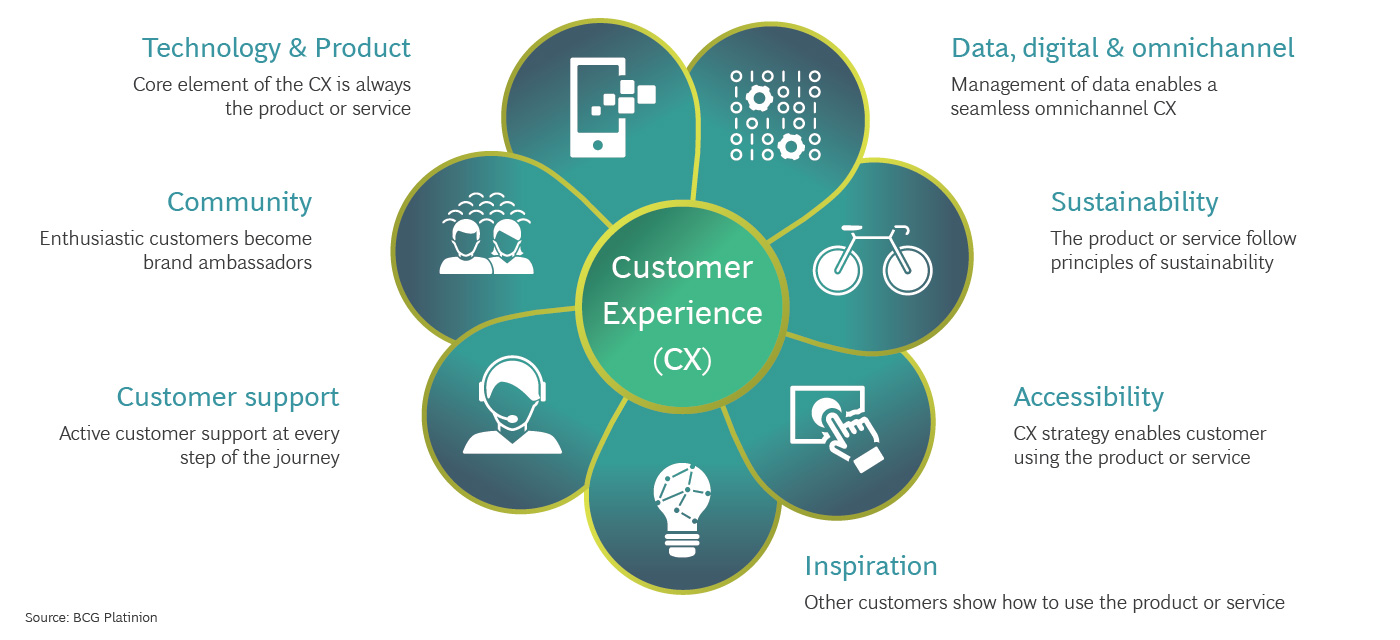The decision about a company’s success rests with the customers. The sum of all their experiences with a brand has a direct impact on their decision-making process whether to purchase a certain product or not. The challenge Customer Experience (CX) management faces is to create as many favorable episodes as possible for new and existing customers and thus create a sustainable, positive connection between the customer and the brand, product or service.
This is exactly the key to an optimized Customer Experience, which brings many advantages: It will boost revenue, increase the value of the product, bolster customer satisfaction and loyalty, tighten the company-client relationship and even facilitate cost reduction through sustainable investments. The digital transformation opens up many new opportunities for companies to get and maintain a positive connection with their target group. The rise of technologies and communication channels combined with the permanent online accessibility of customers creates the best conditions for making CX a captivating experience.
BCG Platinion has defined core differentiators from which organizations usually define the leading elements of their CX strategy:
The Leading Elements of Customer Experience (CX)

Technology and product—As the core element of the Customer Experience is always the product or service, a strong focus should be placed on that as well as on innovation. All solutions need to add value to the customer plus be easy and simple to use.
Data, digital and omnichannel—The flow of data between the different services is managed and utilized in a meaningful way and should enable a seamless omnichannel Customer Experience.
Planned touchpoints merge into one overall experience, and the customer can switch channels effortlessly.


Community—The goal is to achieve the highest possible degree of customer identification with the company.
Enthusiastic customers become brand ambassadors and recommend the company, brand, or product to others.
Customer support—Service is not reduced exclusively to buyers. Prospective customers can be actively supported and accompanied at every step of their journey—for example, through 24/7 availability.
Individual and interactive communication increases relevance.
Sustainability—The product or service aims to follow principles of sustainability and has a long-term vision of their core elements and how to strategically anchor these in the Customer Experience. Potential customers should be incentivized to support an ecological balance, while using the product or service.
Accessibility—Overall, the CX strategy highlights the enablement of customers using the product or service. The experience of different types of customers should be defined differently, according to their needs and desires.
The CX strategy highlights the enablement of customers using the product or service.
"Inspiration—The Customer Experience is reinforced by other customers who show and highlight how to use the product or service in a meaningful way through influencing and providing new ways and avenues, which might not have been considered so far. Interested customers should be inspired to explore options to experience the product in many various ways.
The weighting of these seven differentiators and their importance for CX depend on the individual company, its business model and future strategy. Regardless, however, three overarching principles apply to the development of a consistent CX: First, develop a basic understanding of the customer’s perception. Second, formulate a concrete CX target definition, and third, consistently implement the new strategy.
1. Understanding emotions
Many companies already know a lot about their customers; for example, they know their sociodemographic characteristics and buying habits. However, they usually are not fully aware of the emotions individual touchpoints and interactions trigger in customers. Fully understanding a Customer’s Experience also means taking subjective perception into account. In the first step, a CX team analyzes the current Customer Journey and the internal organizational structures behind it.
What data sets are collected and what value does this data have? How dynamic are they and how deep do they go to provide interpretable responses from customers? This also raises the question of the extent to which the automated approach can be personalized and individualized and whether exclusively digital touchpoints are sufficient in the course of the Customer Journey or whether physical contact is necessary.
Fully understanding a Customer’s Experience also means taking subjective perception into account.
"2. Dare to re-imagine
Now the creative phase of re-imagining and redefining the elements of the Customer Journey can begin. This is the time for companies to rethink, perhaps reimagine or reinvent their existing channels and touchpoints.
From our experience, it is particularly effective for teams and customers to collaborate on ideas and define pain points throughout the Customer Journey. The goal should be to find out how customers use products and services, why they do so, and what pain points may exist.
3. Establish Test & Learn
The practical test shows whether the new Customer Experience strategy is working. A key success factor is a vibrant feedback culture. Co-creation workshops or feedback sessions ensure transparency. They show whether the Customer Experience is improving and whether innovations are being accepted and yield the desired effect. Good feedback data, strong Customer Experience teams, agile management, and creative solutions help to implement the new strategy.
CX—a question of corporate culture
The organizational and work culture has a significant impact on whether the Customer Experience strategy is successful.
Cross-functional teams of designers and strategists define the processes. Agile working methods and the establishment of a test & learn mentality open up additional perspectives and therefore increase creativity. The change in working methods and the new dynamic relationships between teams must be actively promoted by management.

Improving the Customer Experience is a continuous process of identifying problems, designing solutions, and implementing them in operations. If all levels of the company act cohesively, CX can become the basis for business success.
Discover the rest of our series on Customer Experience:
About the Authors
Iana is a Managing Director at BCG Platinion in Frankfurt, heading Design & Engineering Team in Berlin. Iana leads projects across industries focused on Customer Experience Strategy, Customer Journey Redesign, Design Thinking enablement and Digital, Agile and Human-Centered Transformations. Iana joined BCG Platinion from Nokia & Nokia Bell Labs, where she was leading Transformation by Design and before that was driving Business Operations & Executive Customer Engagement. Prior to that, Iana spent 7 years in management consulting at McKinsey & Company Inc. Connecting different disciplines was always Iana’s passion, which is reflected in her multidisciplinary studies, including a Dr. degree in Business Administration from RWTH Aachen University, Dipl. in Mathematics, BA in Philosophy & Economics, and further qualifications in Design, Fine Arts and Music.
Martin has a strong focus on designing human-centered digital experiences within the practice areas of BCG Platinion solving strategic design challenges through the application of qualitative and quantitative research. He is a strong advocate for behavioral design concepts like gamification and contributes to the emerging research stream of human-centered artificial intelligence (HCAI). Furthermore, he focuses on other topics such as design due diligence (DDD), design leadership and design strategy for Metaverse applications.
Robert is a Senior Strategic Designer in the Berlin office of BCG Platinion. His core proficiencies include large scale qualitative and quantitative research practices, customer experience journey mapping, technological design flow management, as well as UX/UI best practices and benchmarking.




